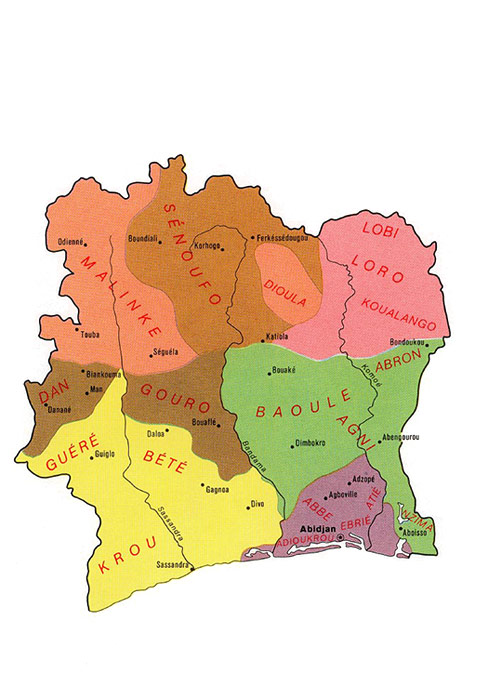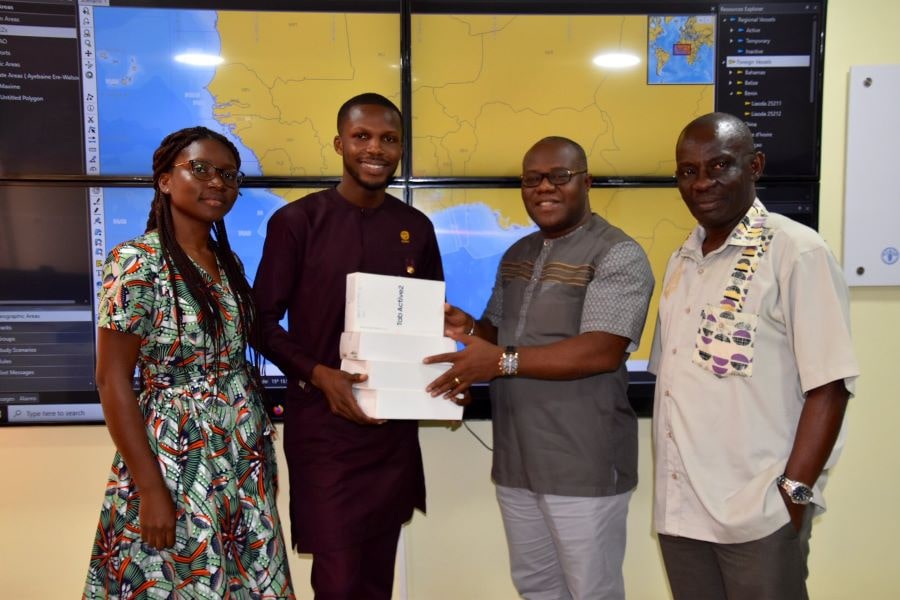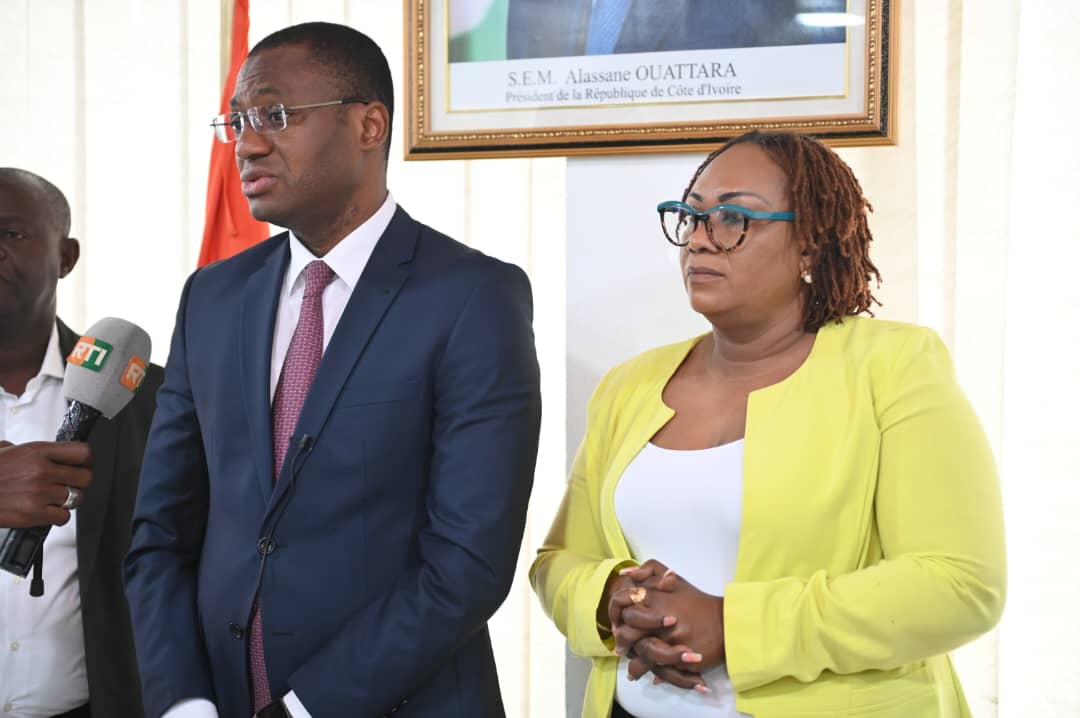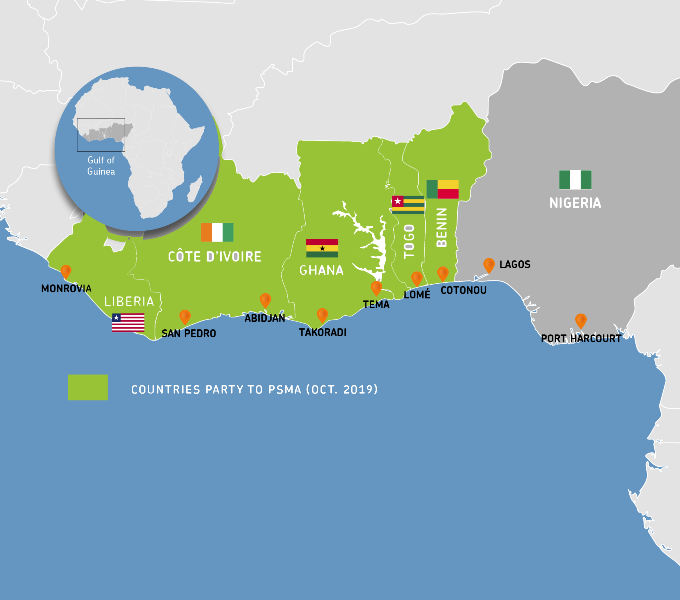
Map of Côte D’Ivoire
Imports: Mainly whole frozen fish, from West Africa, Europe and Asia, including small pelagic species and tunas
Exports: is mainly processed tuna to Europe
Port: Abidjan is the largest tuna handling port in Africa
| Website | https://ressourcesanimales.gouv.ci/accueil/ |
| Ministry | Minister of Animal and Fisheries Resources |
| Minister | Mr. Sidi Toure |
| Director | Mr. Bina Fofana |
| Head of MCS | Maxime Diomande |
| Country Flag |
 |
| Length of coastline (km) | 515 |
| Area of EEZ (km2) | 174,545 |
| Contribution of fish to animal protein consumed | 38.7% |
| People employed | 97,102 |
| Contribution of fisheries to GDP | 0.43% |
| Bottom trawlers | 29 |
| Shrimp trawlers | - |
| Pole and line vessels | 1 |
| Tuna purse seiners | 49 |
| Sardine purse seiners | 21 |
| Longliners | 2 |
GENERAL INFORMATION ABOUT COTE D’IVOIRE RELATED TO FISHERIES
The fisheries sector in Ivory coast is an at the same time importer and exporter. The sector produces 30% of locally consumed fish (consumption is estimated at 275,000 tonnes (t) is 16,2 kg/capita/year). The marine fishing sector lands annually about 63,000 (t), Lagoon and inland fisheries produces about 30,000 (t). The deficit of about 182,000 (t) is imported.
Import and exports of the fisheries sector becomes even more complicated as there are three processing plants which produce annually 121,000 of canned Tuna for export.
The fisheries sector contributes about 3.2% of the agricultural GDP, its contribution to the total GDP is to 0,8% and it generates annually 66 billion franc CFA.
Ivory Coast has a coastline of 550 km, a continental shelf of 11,000 km2, three lagoons (Ebrié, Aby and Tadjo) covering 1,500 km2, of four large artificial lakes which (Ayamé, Kossou, Buyo and Taabo), and 1,700 km2 of rivers and streams.
STRUCTURE OF THE FISHERIES SECTOR
The fishing fleet
The fishing fleet in Ivory Coast encompass:
- Trawlers: in 1997 the Ivory Coast counted 20 trawlers. This number is relatively stable (17 in 2001) and includes 6 foreign trawlers (35 percent);
- Sardine fishing vessels: 22 in 1997 which reduced to 13 in 2001;
- Shrimp vessels, from 4 in 1997 their number increased to 8 in 1999. However none were operational in 2001;
- Foreign owned Tuna vessels (24 purse seiners, 5 french. 19 spanish);
- the artisanal fleet, primarily made up of dugouts canoes operating at the lakes, lagoons and at sea. The artisanal fleet operating at sea are motorized.
Artisanal fisheries
- Marine artisanal fisheries: Marine artisanal fisheries is practiced by the fishermen with gill nets and hook and line from motorized dugout canoes, also the seines of beach are used. The peak fisheries seasons of is from December to February and July to September.
- Artisanal lagoon fisheries: Lagoon fisheries in Ivory Coast is regarded as a marine fisheries because it is covered by the service in support of artisanal marine and lagoon fisheries.
- Inland artisanal fisheries: Ivory Coast has four principal artificial lakes created for hydro-power generation which are the principal places of inland artisanal fisheries. They are the Lakes Kossou (800 km²), Buyo (600 km²), Ayamé (160 km²) and Taabo (70 km²). The major species caught by inland fisheies are: Oreochromis niloticus, Chrysichthys spp, Heterotis niloticus, Heterobranchus spp, Labeo coubie, Alestes spp and Hemichromis fasciatus
Industrial fisheries
Industrial marine fisheries is important for the local market. About 20 national trawlers exploit the fish resources on the continental shelf and land their catch in Abidjan. The foreign vessels do not land in Abidjan.
Tuna fisheries
The Oceanographic Research Center (CRO) deals with the research of high seas fish resources, especially Tuna and Swordfish. It should be noted that management decisions on these stocks are taken to ICCAT, but Ivory Coast contributes to the management of these resources through the transmission the results of the Tuna observatory in the fishing port in Abidjan. The Tuna Observatory collects statistics on the quantities of tunas, by species, landed for the processing plants. Tunas which are refused by the processing plants arrive at the local markets and are not monitored. A programme of collection of the statistics for this group “Faux poisson” started in 2006 for better knowing the order magnitude of this category of fish.
Tuna fishing is also practiced by artisanal fishermen who land the catches of their gill nets.
Marine resources
Pelagic resources
The majority of the artisanal fishermen target the small pelagic, i.e. the sardinelles, pikes (barracudas), carangues (Caranx spp), Brachydeuterus auritus. Other pelagics targeted are marlins, sailfish and Spanish mackerels.
It should be noted that the continental shelf of the Ivory Coast is relatively narrow, explaining the relatively low fisheries potential of Ivory Coast which hardly exceed 10.000 tons of biomass. The sardine fisheries is based in Abidjan, their catches are composed of the small pelagics (Sardinelles, Maquereaux, Pelons, Anchois), which are resources shared with Ghana and to a lesser extent with Togo and Benign. The round sardinella (Sardinella aurita) which knew a collapse in 1974, became again, since1984, the dominant species in the catches
Demersal resources
They are the shellfish, fish resources and cephalopod. The first group is most important; the representatives of the second are also exploited but mainly exported. The cephalopods can be considered by catch as they are not really targeted.
Fish
The fish are subdivided in species which are found on the trawling fishing grounds (flat fish Pseudotolithus spp, Galeoides) and those which live on the rocky bottoms (Lutjanus, Sparus, mérous, etc).
Shrimps
In river mouth areas shrimp are found, which are especially targeted by foreign vessels. To avoid confusion it should be noted that the name “langoustine” is used for the commercial category of shrimps of the Penaeus species.
Source – FAO : WWW.FAO.ORG







